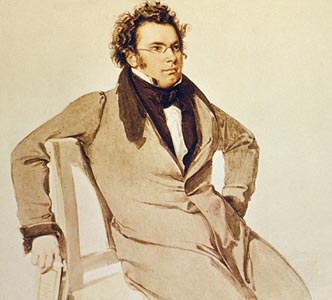Franz Schubert(1797-1828)
Born January 31, 1797 in Vienna (Liechtental), Austria.
Died November 19, 1828 in Vienna.
Symphony No. 7* (8 traditional) in B Minor D. 759 (Unfinished)
Composed in October, 1822.
First Performance: December 17, 1865 with Johann Herbeck conducting the Gesellschaft der Musikfreunde in Vienna.
Instrumentation: 2 flutes, 2 oboes, 2 clarinets, 2 bassoons, 2 horns and 2 trumpets, 3 trombones, timpani and strings.
Schubert composed two movements for the Symphony in B minor (now known as the Unfinished Symphony) in October 1822. It seems that he did not intend for these movements to stand on their own, as he made sketches and scored several measures of a scherzo apparently to continue the work. Unfortunately, no sketches for a finale have ever been found, though there has been some speculation that the Entr’acte in B Minor for Rosamunde
composed in the following year was originally intended to be this symphony’s finale. As one might expect, there have also been several misguided attempts to compose a “completion” to this symphony, (not to mention PDQ Bach’s Unbegun Symphony
) but nothing could ever be added by another composer that would match the perfection of these two movements that stand well on their own.
Schubert was elected an honorary member of the Styrian Music Society in Graz, and in 1823 he sent these movements to his friend Anselm Hüttenbrunner to give to the Society. Somehow Hüttenbrunner failed to deliver them, and the manuscript remained unknown until it resurfaced in 1865. The work was premiered in Vienna that year and has not left the repertory since.
The Allegro moderato first movement begins with a short brooding theme played by the cellos and basses.
[wpaudio url=”http://genedelisa.com/wordpress/wp-content/uploads/mp3/2007/01/Example1.mp3″ text=”Play” dl=”0″]
After the short introduction the second theme is introduced in the clarinets and oboes over an agitated string background.
Example 2.

[wpaudio url=”http://genedelisa.com/wordpress/wp-content/uploads/mp3/2007/01/Example2.mp3″ text=”Play” dl=”0″]
The third and main theme moves from B minor to G major is introduced by the cellos. It is probably the most well known of all Schubert’s melodies.
Example 3.

[wpaudio url=”http://genedelisa.com/wordpress/wp-content/uploads/mp3/2007/01/Example3.mp3″ text=”Play” dl=”0″]
(In my younger days I remembered this theme sung with the words “This is the symphony that Schubert wrote and never finished.”)
This beautiful lyrical melody is abruptly interrupted by forceful tremolos played by the full orchestra, which are followed by fragments of the three themes. This suggests that the development has begun, but then the entire first section is repeated. The development takes the themes apart and introduces interesting harmonic progressions that half a century later could well have come from Wagner. The recapitulation repeats the famous theme and is then followed by the coda, which repeats ideas from the development.
The Andante con moto slow movement begins in E major with the first theme stated by the violins.
Example 4.

[wpaudio url=”http://genedelisa.com/wordpress/wp-content/uploads/mp3/2007/01/Example4.mp3″ text=”Play” dl=”0″]
This lyrical theme is followed by a contrasting “marching” melody.
Example 5.

[wpaudio url=”http://genedelisa.com/wordpress/wp-content/uploads/mp3/2007/01/Example5.mp3″ text=”Play” dl=”0″]
The clarinet introduces another theme that is further developed.
Example 6.

[wpaudio url=”http://genedelisa.com/wordpress/wp-content/uploads/mp3/2007/01/Example6.mp3″ text=”Play” dl=”0″]
The movement ends with a coda that returns softly to the initial violin theme as the movement dies away. We are therefore left with a work that is unfinished but no less a complete masterpiece, leaving the listener with a melancholic wondering of what could possibly have come next had Schubert’s life been extended beyond his early demise. The powerful contrast of Schubert’s towering Ninth Symphony “The Great” seems to leave little doubt that as his own life continued it took him beyond the thoughts of the Eighth Symphony, never to return.
* In 1978 the numbering of Schubert’s symphonies was revised to reflect the chronological order of their composition. The Unfinished Symphony was known before then as No. 8; now it is No. 7. The Great C Major Symphony can be found referred to as No. 7, 8 or 9! It is perhaps better to refer to his symphonies by their nicknames or their Deutsch Catalog number to avoid confusion.
Resources
[amazon template=iframe image&asin=B000001GXE][amazon template=iframe image&asin=B000059T7D][amazon template=iframe image&asin=B000000EDR]
[amazon template=iframe image&asin=0393097315][amazon template=iframe image&asin=3795762782][amazon template=iframe image&asin=B007OLD3F2][amazon template=iframe image&asin=B0000D2Z2J]


Nice article, brief and comprehensive. But please note that the melody pitch _and_ the key signature in example n. 6 are both wrong. The melody should begin with an E, as originally written for the Clarinet in A, and also the key signature should be just one sharp (so the melody is written in E minor for the Clarinet in A, and sounds in C sharp minor).
The published scores do indeed have the clarinet part transposed.
I chose to use concert pitch for the examples.